Posted by Filiberto Boncompagni on 09-21-2003 05:13 AM:
What is Islamic Textile Art?
Dear All,
One of the subject of discussion in our Salon is that to
understand Islamic Art you have to understand Islam, on which I agree to some
extent.
However, I have a lot of doubts in putting tribal textiles of Muslim
countries in a broad category called "Islamic Textile Art"
(the use of
"tribal art" has no depreciatory meaning but it is only an indicative of the
textiles' origin - as Jon Thompson’s distinction between, TRIBAL, COTTAGE,
WORKSHOP and COURT textile production.)
I already expressed some thought
on this subject in the "POLITICS!" thread and I’m not going to repeat them.
I think it is better to pass here from theory to facts and I’ll present
some scans.
A Mamluk rug, the "Simonetti" Carpet, ca. 1500; attributed to
Egypt
courtesy of the Metropolitan museum:
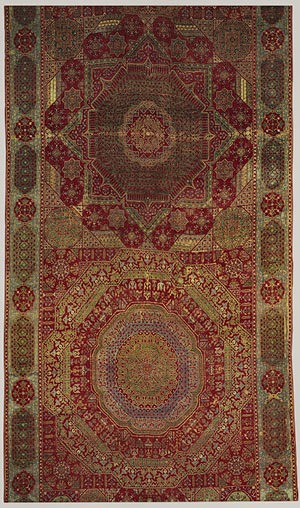
A Persian Shah Abbass design rug,
late 16th century, Corcoran Gallery of Art, Washington D.C.
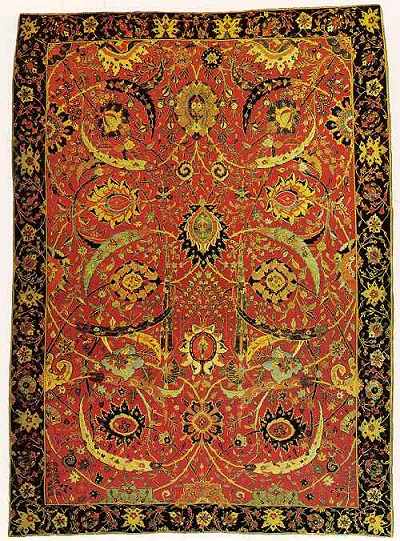
An old Persian rug, Floral and
Animal design, Juseph V. Mcmulllan collection, New York
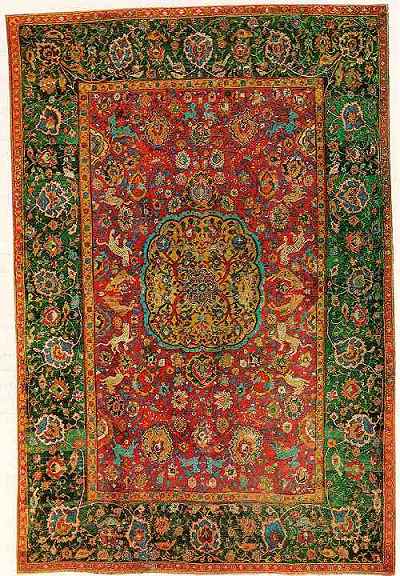
And these are 4 examples
of textile tribal or cottage art from Caucasus:
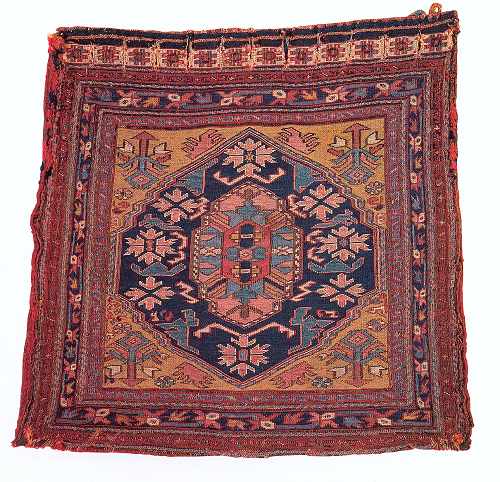
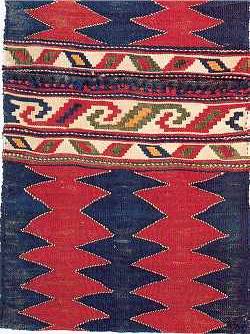

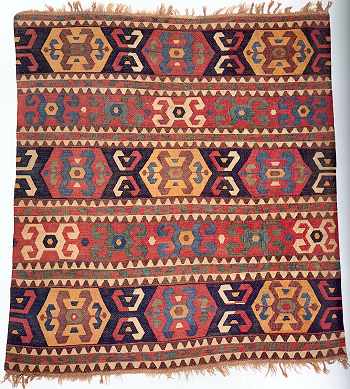
And 3 Turkoman:
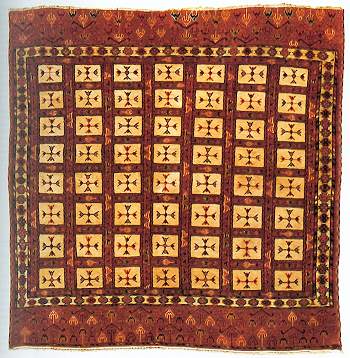
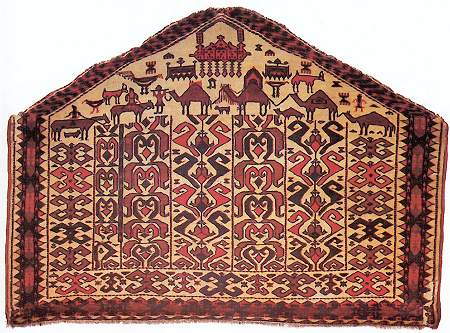
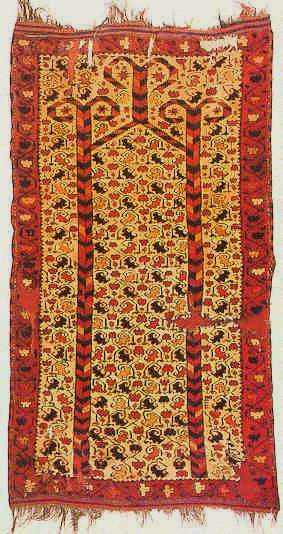
What do you think about those
examples:
Do they all conform to Islamic art?
Do they all fit in the same
category of Islamic Textiles?
Best regards,
Filiberto
Posted by R. John Howe on 09-24-2003 05:00 AM:
Hi Filiberto -
It may be that you addition of the word "textile"
changes the basic shape of your question here but my own thinking is that Wendel
Swan's initial post in another thread, "What is Islamic Art?" answers your
question here about as well as it could be answered.
Is there something
here for you that moves beyond what Wendel has posted in that other
thread?
Regards,
R. John Howe
Posted by Filiberto Boncompagni on 09-24-2003 06:00 AM:
IT IS RIGHT TO CONSIDER TRIBAL ART OF ISLAMIC COUNTRIES AS
ISLAMIC?
Hi John,
Well, perhaps a different title should have been more
appropriate.
Like: IT IS RIGHT TO CONSIDER TRIBAL ART OF ISLAMIC
COUNTRIES AS ISLAMIC?
What I had in mind is to discuss the fact that,
while the first three examples of court/workshop carpets are decidedly Islamic -
to me, at least - the other seven "tribal" examples are not so clearly
definable.
So the answer is: YES, the addition of the word "textile"
should changes the basic shape of my question from a more general context to the
particular "tribal textile" one.
Best regards,
Filiberto
Posted by Stephen Louw on 09-24-2003 08:24 AM:
Dear Filiberto
I agree with your suggestion that "while the first
three examples of court/workshop carpets are decidedly Islamic ... the other
seven 'tribal' examples are not so clearly definable."
However, I think
that part of the problem, and this stems in large measure from our hosts’
presentation, is the tautological manner in which “Islamic Art” is defined. It
is hardly likely -- in fact it defines the imagination -- that illiterate
village weavers understood the tenets and prohibitions within Islam in the same
way that literate city dwellers understood Islamic doctrine. To suppose that
only weavings created within the strict confines of the formal (High) Islam of
the city mosque can be regarded as “Islamic art” is both simplistic and
tautological.
Anthropological studies clearly suggest that at a localised
level people tended to interpret (their version of) Islam through the prism of
extant spirit beliefs and mysticism. This is clearly the case in both Suni and
Shi'a societies. It is only under conditions of modernity, and through
industrialisation, that local weavers and local religious leaders came into
contact with city dwellers and the religious leaders of the city (High Islam).
In Iran, this did not occur until the late nineteenth and early twentieth
centuries. I see no reason why this synthesis of religious beliefs should be
seen as any less Islamic, unless one starts from the judgemental position of the
urban scholar or religious devotee.
Perhaps the best textile
documentation of this interaction between localised spirit beliefs and Islam are
the carpets illustrated in Opie's "Tribal Rugs". In particular, his exploration
of the relationship between the (pre-Islamic) mythology of early Luri bronzes
and pictorial representation in Fars weavings is suggestive of just this. In my
view, it is highly unlikely that these weavers even knew what Tasweer was, and
to suppose – as has been suggested in some of the discussion in earlier threads
-- that their use of pictorial representation undermines their commitment to
Islam in any way is ridiculous.
So I agree with your observation re: the
latter seven (very beautiful) examples of "tribal" art that you have presented
for us.
__________________
Stephen
Louw
Posted by Filiberto Boncompagni on 09-24-2003 11:50 AM:
Dear Stephen,
Glad to hear that you agree with me. Beware, this is not
a comparison based on aesthetics.
I would be more cautious, though,
regarding your affirmation: "It is only under conditions of modernity, and
through industrialisation, that local weavers and local religious leaders came
into contact with city dwellers and the religious leaders of the city (High
Islam)."
I am convinced that those contacts were much more ancient and
frequent than we are inclined to think nowadays.
COMMERCE (besides
Plunder and War) was the main reason for those contacts, and it wasn’t only the
legendary trade on the Silk Road. There were also lesser trades between nomads
(or semi-nomads) and cities over the N. Africa and the M.E.
The article
"TRADE AND EXCHANGE OF NORTH AFRICAN TEXTILE ACCORDING TO EARLY DOCUMENTARY
EVIDENCES" on the "Berber (Amazigh) history and society" thread gives some
insights.
See also this page on Richard E. Wright website:
http://www.richardewright.com/9011_yazd.html
especially
with regard to the Shahsavan.
Now I have to explain in full the reasons
for my doubts in defining those 7 examples of tribal/cottage textiles as
Islamic.
Let us begin with the Caucasian examples.
They all are scans
from Wright & Wertime "Caucasian Carpets & Covers".
The first, from
page 71 is attributed as Azeri or Tat.
The second, from page 135 is
attributed as Azeri or Armenian.
The third, from page 139 is certainly an
Armenian saddle bag: there is an Armenian inscription on the other face (not
visible here because I cut it out from the picture).
The fourth, form page
141 is an "Armenian cover (or possibly Azeri)".
A few considerations on
Tat, Azeri and Armenian ethnicity.
The origin of the Tats is obscure and
literary references are scarce. They have been supposed as being aboriginal
inhabitants of the Caucasus, who gradually, linguistically, iranicized, but
later, in the process of the forming of the Azerbaijani people, did not turn
Turkic. The complexities of their ethnic history are reflected in the fact that
among Tati speakers there are Muslims, Christians and Judaists.
The
Azeris are predominantly Shi'ite Muslims. They combine in themselves the
dominant Turkic strain, which flooded Azerbaijan especially during the Oguz
Seljuq migrations of the 11th century, with mixtures of older
inhabitants--Iranians and others--who had lived in Transcaucasia since ancient
times.
The Armenians are in the region since the 7th century BC, were
converted to Christianity about AD 300 and have an ancient and rich liturgical
and Christian literary tradition.
So, those textiles - with the exception
of the third - could have been woven by people of three different religions.
There is no way to tell which one from the style of the artifact itself, there
are no distinctive clues.
I know several Armenians here in the M.E. They
are very proud and defensive of their culture. I do not think their ancestors
could have copied patterns bearing close or even loose relationship with the
Islamic religion.
By the same logic, also the Azeri would have avoided to
copy a Christian design.
Now, look at the fourth example. Its design (or
at least variations of it) is found on rugs from Anatolia, Caucasus, Persia and
Central Asia.
James Opie suggests that it originated from Luristan, and
"Kurdish tribes in Iran and Anatolia served as a conduit for the passage of a
basic tribal design vocabulary from an area to the other".
My idea is
that some motifs, like this one, largely pre-existed current religions and were
already common heritage to people of different ethnicity. Sort of a textile
"lingua franca" if you like, that makes "politically correct" its adoption by
different ethnic groups.
Now for the Turkoman:
The first Turkoman
is a Yomut from Uwe Jourdan’s "Turkoman: Oriental Rugs". I chose it because the
design of its field reminds so much of the 3000(?) years old Pazyrik Rug and a
stone floor carving at Nineveh… (see Opie, page 33). Not too much of Islamic
influence here.
The second Turkoman, a Yomut Asmalyk is also from
Jourdan’s book.
The apex is closed by the depiction of a "tumar" - a
container for amulets. The rest of the composition with its wedding caravan and
the field decoration (with motifs that remind me of designs from central Asian
felts) has very little of Islamic, in my opinion. I see more an older Shamanic
culture, there.
The last is Dudin’s Ersari-Beshir. I chose it, in spite
of it being a prayer rug because I think the horns-like motifs (Kotshaks) are
probably much older than Islam… and because I like it.
Conclusion:
Uh… do I really have to write a conclusion? It’s already a too long
posting…
Best regards,
Filiberto









